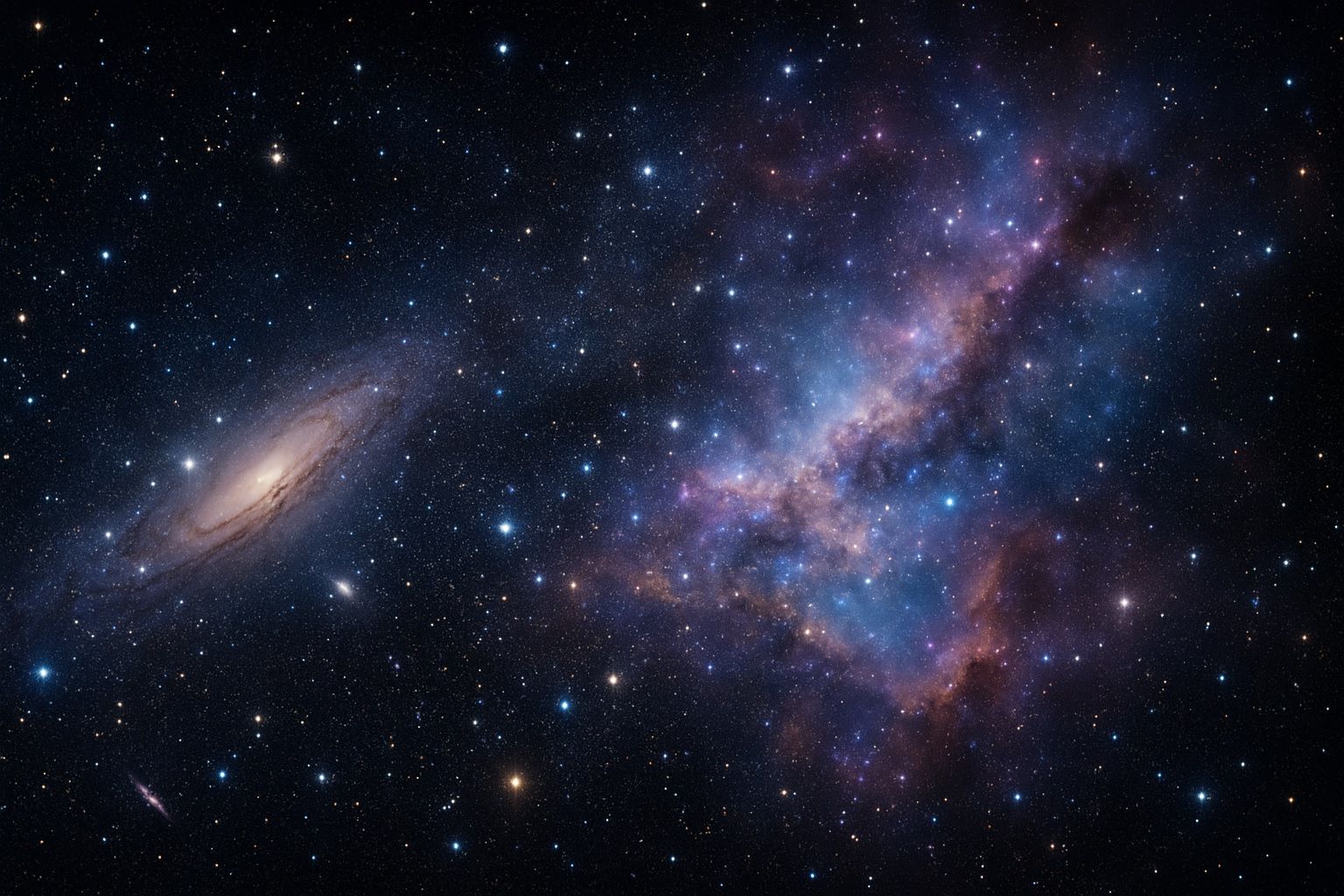- The Nancy Grace Roman Space Telescope is planned to launch in late 2026 (latest commitment by May 2027) aboard SpaceX’s Falcon Heavy to a halo orbit around the Sun-Earth L2, about 1.5 million kilometers from Earth.
- Roman uses a 2.4-meter primary mirror repurposed from Hubble and a 300-megapixel Wide Field Instrument that covers about 0.28 square degrees, enabling sky surveys roughly 1,000 times faster than Hubble.
- Its Coronagraph Instrument aims to directly image exoplanets and disks by suppressing starlight with deformable mirrors, potentially detecting planets a billion times fainter than their stars.
- Roman’s microlensing survey is expected to find over 2,000 new exoplanets, including Earth analogs and free-floating planets.
- PLATO will consist of 26 cameras with 81.4-megapixel detectors, producing a combined >2-billion-pixel image and covering about 5% of the sky.
- PLATO targets Earth-sized planets in the habitable zones of Sun-like stars and will determine host-star ages with about 10% precision through asteroseismology.
- PLATO is scheduled to launch in late 2026 from Europe’s Spaceport in Kourou on Ariane 6 to the Sun-Earth L2 halo orbit, with a baseline of 4 years (extendable to 8).
- ATHENA is planned to launch in 2037 on an Ariane 64 rocket to a halo orbit around the Sun-Earth L1, about 1.5 million kilometers from Earth, with a baseline of five years and potential extension to ten.
- ATHENA will carry the X-ray Integral Field Unit (X-IFU) microcalorimeter with about 3,000 sensors cooled to 0.05 kelvin, achieving roughly 2.5 eV energy resolution, plus the Wide Field Imager (WFI) for broad X-ray surveys.
- ATHENA aims to map the warm-hot intergalactic medium and study black-hole growth and feedback to understand galaxy evolution and the missing baryons problem.
In the coming decade, a trio of advanced space observatories will open new windows on the universe, tackling some of the most profound mysteries in astronomy. These next-generation telescopes – NASA’s Nancy Grace Roman Space Telescope, and the European Space Agency’s PLATO and ATHENA missions – are poised to revolutionize our understanding of everything from dark energy and galactic evolution to exoplanets and high-energy phenomena. Each telescope has distinct goals and cutting-edge technology, but all share a common purpose: to expand our cosmic vision and rewrite the story of the cosmos. Below, we explore each mission in depth, followed by a comparative summary of their key features.
Nancy Grace Roman Space Telescope
Overview and Mission Goals: The Nancy Grace Roman Space Telescope (often just “Roman”) is NASA’s next flagship observatory after the James Webb Space Telescope. Named after NASA’s first Chief of Astronomy, Nancy Grace Roman, this mission is designed to tackle some of the most pressing questions in astrophysics. Roman’s primary objectives are to unravel the mysteries of dark energy and dark matter, explore the growth and structure of the universe, and discover new exoplanets [1] [2]. Unlike Hubble or Webb, which focus on narrow, deep views, Roman will conduct wide-field surveys – capturing patches of sky 100 times larger than Hubble can in a single image [3]. This wide-angle vision will allow it to map the cosmos on a grand scale, potentially observing billions of galaxies and other cosmic objects across space and time [4]. By surveying large swaths of the infrared universe, Roman aims to shed light on how cosmic structures evolved and to test theories of cosmic acceleration driven by dark energy [5] [6]. At the same time, Roman will perform a massive hunt for distant worlds, using its unique tools to find exoplanets even in regions and by methods previously inaccessible.
Launch Timeline and Mission Duration
Roman is currently under development and planned for launch in late 2026 [7] (with a latest commitment no later than May 2027). SpaceX’s Falcon Heavy rocket will send Roman toward a halo orbit around the Sun–Earth Lagrange Point 2 (L2), about 1.5 million kilometers from Earth [8]. Once there, Roman will operate in tandem with other L2 observatories (like Webb), benefitting from a stable, cold space environment ideal for infrared observations. The baseline mission duration is five years [9], long enough to complete its planned sky surveys. However, like Hubble and other predecessors, Roman could be extended well beyond that if all goes well – potentially yielding a decade of groundbreaking data. Key development milestones have been met: as of 2024, the telescope’s hardware and instruments have been integrated and tested, keeping it on track for the 2026 launch [10] [11].
Key Technologies and Instruments
Roman’s design takes advantage of a 2.4-meter primary mirror, repurposed from surplus hardware, which gives it Hubble-like resolution [12]. What sets Roman apart is its Wide Field Instrument (WFI) – a 300-megapixel infrared camera made of 18 large detectors, giving Roman a field of view about 0.28 square degrees on the sky [13]. This is roughly 100 times larger than Hubble’s field of view at similar resolution [14]. In practical terms, Roman can survey the sky 1,000 times faster than Hubble, enabling rapid mapping of huge areas [15]. The WFI covers optical and near-infrared wavelengths (approximately 0.5 to 2.3 μm) [16] [17], making it sensitive to both visible light and the heat glow of distant galaxies.
In addition, Roman carries a pioneering Coronagraph Instrument (CGI). The CGI is essentially a high-contrast camera with specialized optics that block out a star’s light, enabling direct imaging of exoplanets and disks around that star [18]. This technology demonstration will attempt to spot planets on orbits somewhat like our outer planets, down to worlds perhaps a billion times fainter than their host stars. It uses deformable mirrors and masks to cancel starlight – a stepping stone toward future missions that could directly image Earth-like exoplanets. While CGI is experimental, its success could usher in “seeing” exoplanets in reflected light for the first time. Together, the WFI and CGI make Roman a versatile observatory: one built for sweeping cosmic surveys and another pushing the envelope of exoplanet imaging [19].
Targeted Scientific Questions and Discoveries
Roman’s science program centers on two broad themes: cosmology and exoplanets. In cosmology, Roman will address questions like: What is the nature of dark energy? Has the universe’s expansion changed over time, and is Einstein’s theory of gravity fully accurate on cosmic scales? To tackle this, Roman will survey millions of galaxies and galaxy clusters across different epochs. By observing distant supernovae (exploding stars) and mapping the weak gravitational lensing distortions of galaxy shapes, Roman will refine measurements of the universe’s expansion history [20]. One Roman survey will catalogue thousands of Type Ia supernovae in remote galaxies – standard candles that help pin down the Hubble constant (the cosmic expansion rate) [21]. Another survey will measure the subtle stretching of galaxy images by intervening dark matter, providing clues about the distribution and nature of dark matter in the universe. Through these studies, Roman aims to test whether dark energy behaves like Einstein’s cosmological constant or something more exotic, and whether spacetime is curved or perfectly flat on large scales [22].
On the exoplanet front, Roman will conduct a galactic exoplanet census. Peering toward the dense star fields of the Milky Way’s central bulge, Roman will use gravitational microlensing to detect planets by the thousands [23] [24]. In microlensing, if a foreground star (with or without planets) passes precisely in front of a more distant star, the foreground star’s gravity bends and amplifies the background star’s light. Roman will monitor the brightness of millions of stars, watching for the telltale blips when a star-and-planet system lenses a background star [25]. This technique can reveal planets at wide orbits (even rogue “free-floating” planets not orbiting any star), complementing the transit method used by missions like Kepler. Roman’s microlensing survey is expected to find over 2,000 new exoplanets, including many analogs of Earth, and even planets roaming between the stars [26]. Additionally, by continuously observing stellar fields, Roman could detect upwards of 100,000 transiting exoplanets via the transit method as a byproduct [27] – though transit surveying is not its primary design, its data will be mined for periodic dips in starlight too. Finally, the Coronagraph Instrument may directly image large exoplanets (Jupiter-size or smaller) around nearby stars, allowing scientists to study those worlds’ atmospheres and orbits in ways not possible before.
Importance in the Context of Space Science and Astronomy
The Nancy Grace Roman Space Telescope is often described as the next leap in survey astronomy. By combining Hubble-like sharpness with a panoramic field of view, Roman will fill a critical niche in observing capability. For cosmologists, Roman will provide an unprecedented statistical power – surveying a billion galaxies or more to map large-scale cosmic structures and trace the universe’s expansion [28]. This will vastly improve constraints on dark energy models and could reveal subtle cracks in our standard cosmological model if they exist. Roman’s dark matter maps (via weak lensing) will complement those from the ESA’s Euclid mission (launched in 2023), and together they will deepen our understanding of how invisible dark matter scaffolds galaxies and clusters [29]. In essence, Roman’s wide-view eyes will help answer fundamental questions about the fate and fabric of the universe [30].
In exoplanet science, Roman’s impact will be equally profound. Its microlensing survey will probe a population of planets – including cold, distant planets and lone wanderers – that are inaccessible to transit or radial-velocity methods [31]. By finding such planets by the thousands, Roman will complete the planetary census started by Kepler and continued by TESS, giving a full picture of the distribution of planets from inner to outer orbits. It might find analogs of our own Jupiter and Neptune at distances where transits are rare, and even offer the first statistical data on free-floating planets the size of Mars or Earth. This informs theories of planetary formation and migration (e.g. how many planets get ejected from newborn systems?). Moreover, Roman will serve as a powerful synergy partner for other observatories: for example, it can identify promising exoplanet targets (and even exomoons or rings) for Webb or upcoming giant telescopes to follow up [32]. Its wide surveys of galaxies and transients will also feed targets to observatories across the spectrum. In short, Roman stands to be a game-changer – much as Hubble and Webb have been – by combining breadth and depth in a single mission. It ensures that the 2020s and 2030s will be an era of data-rich astronomy, paving the way for discoveries we have yet to imagine.
PLATO (PLAnetary Transits and Oscillations of Stars)
Overview and Mission Goals: PLATO is the European Space Agency’s ambitious new planet-hunting space telescope, named as an acronym for “PLAnetary Transits and Oscillations of stars.” As the name suggests, PLATO has a dual mission: discovering Earth-like exoplanets around Sun-like stars via the transit method, and probing the internal oscillations of stars (asteroseismology) to understand stellar properties [33] [34]. The overarching question driving PLATO is “Does a second Earth exist in the universe?” [35]. To answer this, PLATO will focus on finding and characterizing rocky planets in the habitable zones of their stars – the “Goldilocks” zone where conditions might allow liquid water on a planet’s surface [36]. It will target relatively bright, nearby Sun-like stars, which are ideal for follow-up studies. By measuring slight dips in starlight when planets transit (cross in front of their stars) and by simultaneously measuring subtle brightness pulsations caused by “starquakes,” PLATO will deliver not only new worlds, but a wealth of information about their host stars’ ages and structures [37] [38]. This combination lets scientists determine a planet’s radius (from transits), mass (via follow-up radial velocity and transit timing, to about 10% precision), and age (from stellar oscillations, to ~10% precision) [39] – a first for exoplanet surveys [40]. In short, PLATO’s goal is to find Earth analogues and compile the first catalog of exoplanets with well-determined sizes, densities, compositions, and ages [41] [42], a huge step toward finding truly Earth-like, potentially habitable worlds.
Launch Timeline and Mission Duration
PLATO is slated to launch in late 2026 from Europe’s Spaceport in Kourou, French Guiana [43] [44]. It will be one of the first major science missions to ride on the new Ariane 6 rocket (using the Ariane 62 configuration) [45]. After launch, PLATO will journey to the Sun–Earth L2 point (the same stable halo orbit used by Webb and Roman) about 1.5 million km from Earth [46]. This location offers a stable thermal environment and an uninterrupted view of the sky. The mission’s baseline duration is 4 years [47], with the possibility of extensions up to 8 years if the spacecraft remains healthy. In its first years, PLATO will likely focus on a few key sky fields for long-duration stares – critical for detecting longer-period planets. The mission timeline calls for about two years of continuous observations on its initial target field, then a shift to another field for a similar duration, balancing sky coverage with the need to catch multi-year orbits. By monitoring some 200,000 stars over several years [48] [49], PLATO aims to detect transits of planets even with orbital periods up to one year or more (hitting the habitable zones of Sun-like stars). All 26 cameras had been integrated by 2025 [50], and the spacecraft was undergoing final assembly and testing in Europe, keeping it on track for the 2026 launch.
Key Technologies and Instruments
PLATO’s most distinctive feature is its “eyes” – an array of 26 cameras working in concert [51]. Unlike a traditional telescope with one large mirror, PLATO has multiple smaller telescopes tiled together. Each camera is a telescopic unit with an 12-cm aperture, equipped with its own set of detectors. Each camera takes 81.4-megapixel images [52], and together the suite of cameras will effectively produce a combined image of over 2 billion pixels – the largest array ever flown for astronomy [53]. This design serves two purposes: it yields a very wide field of view (covering about 5% of the sky at once, by pointing the cameras in slightly offset directions) [54], and it achieves extremely high photometric precision by aggregating light from multiple apertures. Of the 26 cameras, 24 are “normal” cameras optimized for fainter stars, grouped into overlapping fields to cover a big area, and 2 are “fast” cameras dedicated to very bright stars [55] [56]. The fast cameras take images at a higher frame rate to avoid saturating on bright targets and also serve as part of the spacecraft’s fine guidance system [57]. All cameras observe in visible light (broadband optical), since detecting tiny brightness dips requires maximizing photon counts from stars.
The spacecraft is fairly large: about 3.5 × 3 × 3.7 m when stowed, with a 9-meter solar array “wingspan” when deployed to supply power [58]. A sunshield protects the telescopes from direct sunlight, keeping them thermally stable. Inside, PLATO’s payload module houses the camera array and focal plane, while the service module contains propulsion, communications, and onboard computer systems [59]. The use of many cameras posed a significant engineering challenge (the reason for a special mission review in 2022 [60]): all cameras must be coaligned and extremely stable to detect brightness changes of only ppm (parts per million) level. Engineers achieved this by mounting the cameras on a rigid optical bench and using sensitive readout electronics (developed under the lead of the German Aerospace Center, DLR) [61]. The data volume will be huge – but unlike Kepler which downloaded selected star lightcurves, PLATO is expected to process data on-board and downlink key lightcurve data for hundreds of thousands of stars. Europe is building new ground antennas (like a 35 m dish in Australia) to handle PLATO’s data downlink needs [62]. Overall, PLATO’s instrument suite is a marvel of miniaturization and synchronization – dozens of eyes acting together to produce one expansive yet sharp view of the cosmos.
Targeted Scientific Questions and Discoveries
PLATO’s science focus is finding and studying extrasolar planetary systems, with an emphasis on those that might resemble our own solar system. The primary questions include: How common are Earth-sized planets in the habitable zone of Sun-like stars? What are their properties? By detecting transits, PLATO will measure the sizes (radii) of hundreds of planets with exquisite accuracy [63]. For a subset, especially those around bright stars, ground-based observatories will measure their masses (via radial velocities), allowing astronomers to compute densities and infer compositions (rocky vs. gaseous). This will let us identify true “Earth twins” – Earth-sized, likely rocky worlds at the right distance for temperate conditions [64] [65]. PLATO’s long stares mean it can catch planets with longer orbital periods than earlier transit missions: Kepler and TESS found many hot planets with short periods, but PLATO is expected to find cooler planets with orbits of many months up to a couple of years around Sun-like stars [66]. Such planets would include analogues of Venus, Earth, or even slightly wider orbits. Notably, PLATO will also be sensitive to multi-planet systems, detecting multiple transiting planets around the same star and thus revealing architectures of planetary systems.
Beyond planet discovery, PLATO’s other unique contribution is in stellar astrophysics. It will perform asteroseismology on thousands of stars – essentially listening to the “music” of starquakes. These oscillations cause tiny periodic flickers in starlight, from which scientists can decode the star’s internal structure (similar to how seismologists use earthquakes to probe Earth’s interior). PLATO will measure these oscillations for many Sun-like stars, yielding precise ages and evolutionary states for the stars [67]. This has huge implications: knowing a host star’s age allows us to estimate a planet’s age, helping answer questions like how do planetary systems evolve over billions of years? PLATO’s data will improve stellar models and enable comparisons of planetary systems at different stages of life. Moreover, by characterizing host stars better than ever (sizes, ages, rotation), PLATO will tighten the uncertainties in exoplanet properties. For instance, determining an exoplanet’s age and environment can tell us whether a planet might have had time to develop life, or how its atmosphere might have changed over time.
In terms of expected discoveries, PLATO is projected to find hundreds of Earth-sized or super-Earth planets in habitable zones [68] [69], if they are as common as we suspect. It will also find thousands of larger planets (Neptunes and Jupiters) and shorter-period planets, adding to the census. Crucially, PLATO will deliver a list of prime targets – Earth-sized planets around bright, nearby stars – which future missions like the James Webb Telescope (for atmospheric follow-up) or the planned ARIEL mission (which will survey exoplanet atmospheres in the 2030s) can study in detail [70]. In sum, PLATO’s discoveries will extend the search for life-friendly worlds and help answer “Are we alone?” by finding the worlds most like our own. At the same time, it will deepen our understanding of stars, which are the engines and timekeepers of planetary systems.
Importance in the Context of Space Science and Astronomy
PLATO represents a major step forward for exoplanet science and an example of international collaboration in astronomy. Selected as ESA’s third medium-class (M-class) science mission in the Cosmic Vision program [71], PLATO fills a key role in the global effort to find habitable worlds. Its importance can be seen in context with preceding missions: NASA’s Kepler showed that small planets are common, and TESS is currently surveying the whole sky for nearby transiting planets. PLATO will take the next leap by focusing on the elusive Earth analogues – planets with Earth-like size and orbit – which require longer observations and high precision. A confirmed Earth twin orbiting a Sun-like star, with known age and composition, would be a landmark discovery; PLATO is specifically designed to deliver such candidates. By characterizing host stars via asteroseismology, PLATO also ensures that any Earth-like planets it finds have well-measured star properties, which is crucial for assessing habitability. This star-plus-planet approach will revolutionize our understanding of planet formation and evolution [72], as we will be able to compare systems of different ages and see how planets change over billions of years.
Another aspect of PLATO’s importance is its role in a coordinated exoplanet exploration program. It is one part of a trio of ESA exoplanet missions: CHEOPS (launched 2019, doing follow-up characterization of known exoplanets), PLATO, and ARIEL (planned ~2029, to survey exoplanet atmospheres) [73]. PLATO’s discoveries will directly feed ARIEL’s target list and also complement NASA’s James Webb and upcoming giant ground telescopes, which can observe the atmospheres of the larger or closer planets PLATO finds. In a broader sense, PLATO will provide the statistical groundwork to answer, “How common are worlds like our own?” – a question of profound significance. Culturally and scientifically, finding potentially habitable planets around Sun-like stars would be one of the most exciting advances of our time.
From a technological standpoint, PLATO’s success will demonstrate the power of modular telescope design (many eyes instead of one) in space astronomy. If successful, this approach could be used in future missions where extremely high precision is needed over wide fields. Finally, PLATO showcases European leadership in space science: developed by ESA with contributions from its member states (with DLR Germany leading the payload consortium) [74], and with likely participation of international partners, PLATO solidifies Europe’s role at the forefront of exoplanet discovery. Its findings will not only expand our knowledge of distant worlds but also help place our Solar System into cosmic context, showing where we stand among the myriad planetary systems in our galaxy.
ATHENA (Advanced Telescope for High-ENergy Astrophysics)
Overview and Mission Goals: ATHENA is Europe’s next great observatory in high-energy astronomy – an X-ray telescope of unprecedented power. The mission’s name stands for Advanced Telescope for High-ENergy Astrophysics, and it is conceived as the largest X-ray observatory ever built [75]. Developed by ESA as a flagship “L-class” mission, Athena’s broad goal is to observe some of the hottest and most energetic phenomena in the Universe with extraordinary clarity [76]. In practical terms, Athena will investigate explosive and extreme events – from the tumult around supermassive black holes, to merging galaxy clusters, to stellar explosions. Two driving questions shape Athena’s science: (1) How and why does ordinary matter assemble into the large-scale structures we see (galaxies, groups, and clusters)?, and (2) How do black holes grow and influence their surroundings? [77]. These relate to understanding the formation of the cosmic web and the co-evolution of galaxies and black holes over cosmic time. To answer them, Athena will perform tasks like mapping the million-degree hot gas in intergalactic space (which constitutes the “missing” ordinary matter in the universe), and surveying the sky for X-ray emissions from accreting black holes across cosmic history [78]. Athena is thus often framed as addressing the theme of “The Hot and Energetic Universe.” Additionally, as a general-purpose observatory open to the worldwide community, Athena will be used to study a wide range of high-energy targets: neutron stars, supernova remnants, magnetars, active galaxies, and even exoplanet aurorae – virtually every corner of modern astrophysics that involves high-energy processes could be revolutionized by Athena’s capabilities [79].
Launch Timeline and Mission Duration
After a recent rescope of the mission design to meet budget constraints, “NewAthena” is now planned to launch in 2037 [80] [81]. (Originally, Athena was targeted for ~2031, but the schedule has been adjusted following a redesign in 2022–2023.) The mission is in a study phase as of 2025, with a final design and go-ahead (“adoption”) expected by 2027 [82]. Athena will launch on an Ariane 6 heavy-lift rocket (specifically the Ariane 64, with four solid boosters, to accommodate Athena’s large mass) [83]. Once in space, Athena will cruise to a halo orbit around the Sun–Earth Lagrange Point 1 (L1) [84]. This orbit, about 1.5 million km from Earth toward the Sun, provides a stable environment with minimal Earth occultation for X-ray observations (unlike optical telescopes, X-ray observatories are less affected by thermal variations but still benefit from steady conditions and continuous sky visibility). The baseline mission lifetime is five years [85], with a possible extension to ten years or more if resources allow. Five years of Athena operations are expected to yield tremendous volumes of data, as the mission will perform both planned surveys and respond to targets-of-opportunity like new transient events. In fact, Athena is being designed to be highly responsive to cosmic events – it will be able to repoint within 4–12 hours to catch things like gamma-ray bursts or new supernovae that other instruments alert it to [86] [87]. This agile scheduling (with roughly 5 target-of-opportunity observations per month) [88] means Athena can capitalize on unpredictable high-energy phenomena, a crucial capability in an era of multi-messenger astronomy.
Key Technologies and Instruments
To achieve its science goals, Athena will carry a suite of powerful X-ray optics and detectors. At its core is an X-ray telescope with a 12 m focal length, featuring the largest collecting area of any X-ray observatory to date [89]. Because X-rays cannot be focused by ordinary mirrors (they would mostly penetrate or be absorbed), Athena’s telescope uses specialized mirror modules – likely employing ESA’s innovative silicon pore optics technology, which stacks thousands of precisely shaped mirror segments in concentric rings. This design yields a high-effective area (on the order of >2 square meters at 1 keV energy, far exceeding current X-ray telescopes) and a fine angular resolution (with a goal of around 5 arcseconds) [90] [91]. The 12 m focal length (the distance from mirror to detectors) may require an extendable optical bench or deployable structure due to launch vehicle size limits. At the focus, Athena will host two advanced instruments [92]:
- The X-ray Integral Field Unit (X-IFU) – a state-of-the-art X-ray spectroscopic imager [93]. The X-IFU is essentially a microcalorimeter array: about 3,000 tiny sensors cooled to a fraction of a degree above absolute zero, which measure the energy of incoming X-ray photons with incredible precision [94]. Each X-ray photon’s energy (or “color”) is detected, producing a spectrum for every pixel in the image (hence “integral field”). This provides high-resolution spectroscopy (energy resolution ~2.5 eV) for each point in an extended source, allowing Athena to map, for example, the temperature and velocity of gas in a cluster or the chemical make-up of supernova debris. The X-IFU is an international effort led by France, with substantial contributions from countries across Europe and NASA; notably, NASA is providing the sensor array for this instrument [95] [96].
- The Wide Field Imager (WFI) – a complementary wide-field X-ray camera [97]. The WFI uses a large array of silicon detectors (likely DEPFET active pixel sensors) to capture X-rays over a large field of view (several tens of arcminutes) with lower spectral resolution but high count rate capability [98]. This means the WFI can observe bright sources or perform surveys without saturating, and can image broad areas to find faint objects. The WFI will enable Athena to conduct X-ray surveys much faster than previous missions, scanning for things like distant quasars or tracking large-scale structures. The WFI is led by a consortium in Germany (Max Planck Institute for Extraterrestrial Physics) with contributions from other ESA member states and the U.S. [99].
Athena’s spacecraft systems will support these instruments with precision pointing and thermal stability. The telescope will likely weigh several tonnes (early estimates were ~5–7 tonnes launch mass) and span ~15 m in length including the instrument module and mirror. It will have a large deployable solar array to power the cryocoolers and electronics. One challenge is maintaining the microcalorimeter at extremely low temperatures in space – Athena will carry a multi-stage cooling system (with mechanical coolers and possibly a cryogenic radiator) to keep the X-IFU near 0.05 K. Athena also needs low background noise: it may have shielding to block cosmic rays and an orbit chosen to minimize charged particle flux. All these technologies are evolutions of those flown on previous missions (like XMM-Newton, Hitomi, and XRISM), but Athena pushes them to new performance levels. The result will be a telescope that exceeds the capabilities of current X-ray missions by factors of ten in several metrics (sensitivity, imaging spectroscopy, survey speed) [100], truly a leap into the future for high-energy astrophysics.
Targeted Scientific Questions and Discoveries
Athena’s science program is comprehensive, but its core focused objectives can be summarized by two questions from ESA’s science definition: How does ordinary matter assemble into galaxies and clusters? and How do black holes grow and shape their environments? [101]. To tackle the first question, Athena will observe the intergalactic medium (IGM) – the tenuous hot plasma that lies between galaxies. Simulations and indirect evidence suggest that a significant fraction of the universe’s normal matter (baryons) exists as a hot diffuse gas in filaments connecting clusters, often called the warm-hot intergalactic medium (WHIM). Athena’s sensitive spectra will be able to detect this gas through faint X-ray emission lines and absorption lines, essentially mapping the “missing” baryons that have been hard to find [102]. By surveying galaxy clusters and groups, Athena will chart how gas is distributed, measuring its temperature, density, and chemical composition. This will show how structures grew over time – for instance, by comparing distant (young) clusters to nearby (old) ones, we can see how they accumulated gas and heavy elements. Athena will also study cluster mergers and shocks, observing phenomena like gas sloshing and enormous shock fronts as clusters collide. These observations address how energy feedback (from galaxies, supernovae, etc.) spreads heat through the cosmic web.
For the second question, Athena will be a black hole hunter par excellence. It will have the sensitivity to detect X-ray signals from supermassive black holes in the early universe, even those obscured by gas and dust. By looking out to high redshifts, Athena aims to discover the first generation of growing black holes, perhaps less than a billion years after the Big Bang [103]. This will inform us how black holes seed and grow – whether by rapid accretion or mergers. Athena will perform wide X-ray surveys to find hundreds of thousands of active galactic nuclei (AGNs) across cosmic time [104]. It will also scrutinize nearby active galaxies in exquisite detail: with X-IFU, Athena can map the outflows and winds emanating from around black holes (through X-ray emission/absorption lines of iron, oxygen, etc.), telling us how black hole energy input (jets, radiation) heats or blows away surrounding gas. This feedback process is believed to regulate galaxy evolution (preventing galaxies from over-growing), so Athena’s data will directly test these theories by observing feedback in action. Additionally, Athena will study the endpoints of stellar evolution – it can inventory X-ray binaries and accreting stellar-mass black holes in other galaxies, and observe tidal disruption events when stars are shredded by black holes.
Aside from these primary goals, Athena’s versatility means it will likely make myriad discoveries: for example, measuring the magnetic fields of neutron stars by detecting polarization-dependent X-ray cyclotron lines, or observing the X-ray flares on exoplanets driven by their parent stars. It will also be a tremendous follow-up instrument for transient events discovered by gravitational-wave detectors or other observatories. In a pioneering multi-messenger partnership, Athena is expected to operate concurrently with LISA, the space-based gravitational wave observatory (planned for 2035). Together, they can observe events like black hole mergers both in gravitational waves (LISA) and X-rays (Athena) – a one-two punch that yields far more insight than either alone [105]. For instance, if LISA detects the merger of massive black holes, Athena could potentially see the X-ray flash or aftermath, helping pinpoint the event’s location and the physics of the merger [106]. This synergy can also refine the cosmic distance scale and test fundamental physics (like the speed of gravity) [107]. In summary, Athena will be the workhorse that examines the extremes of the universe – from the colossal energies of quasars and galaxy clusters to the fleeting signals of cosmic explosions – answering key questions and undoubtedly raising new ones about our high-energy universe.
Importance in the Context of Space Science and Astronomy
ATHENA is poised to be for high-energy astrophysics what Hubble/Webb have been for the optical/IR – a transformational observatory. Its importance can be appreciated on several levels. First, it will fill a looming gap in X-ray astronomy. By the mid-2030s, current X-ray missions (like NASA’s Chandra and ESA’s XMM-Newton) will be over 3 decades old and likely beyond operation. Athena ensures that astronomers will have a powerful X-ray eye to continue exploring the energetic side of the universe. With its huge jump in capabilities, Athena will extend our reach: for example, where XMM-Newton might barely detect a distant quasar, Athena will get a detailed spectrum; where Chandra sees a hint of shock in a cluster, Athena will map its properties fully. Essentially, Athena will unlock new discovery space in the X-ray regime – much as a larger telescope lets you see fainter and further, Athena will reveal X-ray sources and spectral details previously impossible to observe [108].
Scientifically, Athena’s impact will span cosmology, galaxy evolution, and fundamental physics. By finding the universe’s missing matter and tracking how it flows into galaxies and clusters, Athena will answer an outstanding question of where the baryons (ordinary matter) have been hiding [109]. This ties into understanding the chemical enrichment of the universe – Athena’s spectra can measure element abundances in intergalactic space, offering clues to how elements dispersal from star formation might have happened. In studying black holes, Athena will clarify the role of these enigmatic objects in shaping galaxies. Are black holes the main regulators that keep galaxies from forming too many stars (via energy feedback)? Athena’s observations of feedback in action will either solidify or challenge these models. There’s also potential for discovering new phenomena: e.g., intermediate-mass black holes in galaxy halos, or unknown X-ray transients. By being able to react quickly to events, Athena will integrate into the global network of observatories – if a neutron star merger is detected (with gravitational waves and gamma rays), Athena could be the instrument that observes the resulting X-ray afterglow or kilonova remnant, providing invaluable information on these events.
From a technological and collaborative standpoint, Athena underscores the importance of large international partnerships in modern astronomy. It is an ESA-led mission with significant contributions from NASA and JAXA (Japan) [110] [111]. The instruments are being built by consortia of many countries; for instance, the X-IFU involves 11 countries and hundreds of scientists [112]. This global effort is necessary because Athena is extremely ambitious in scale and complexity. If successful, it will demonstrate advances in X-ray optics (high-throughput, high-res imaging), cryogenics, and detector technology that could also feed forward into other fields (for example, medical imaging or materials science often benefit from advances in X-ray detectors). Furthermore, Athena’s planned overlap with other missions (like LISA) means it will amplify the science output of those missions too – heralding a new era of multi-messenger astronomy where different observatories combine forces to probe phenomena in all their facets [113].
In summary, Athena is critical to ensuring that humanity’s “eyes on the universe” cover the X-ray band with the sharpness and breadth we need to fully understand cosmic history. It addresses fundamental questions of our origins: how the first structures and black holes formed, and how they energetically interacted to shape the universe we see today [114]. Its importance is perhaps best captured by the expectation that Athena will exceed the scientific performance of any prior X-ray mission by an order of magnitude in multiple ways [115]. Just as previous great observatories opened new frontiers (e.g., Chandra’s exquisite imaging or XMM’s spectroscopy), Athena will undoubtedly lead to breakthroughs – possibly discovering new states of matter or unexpected X-ray sources – and will keep high-energy astrophysics at the forefront of discovery well into the 2030s and 2040s.
Comparison of Roman, PLATO, and ATHENA
To appreciate how each of these upcoming telescopes complements the others, the table below summarizes their key features and mission profiles side by side:
| Telescope | Lead Agency (Partners) | Planned Launch | Observation Domain | Primary Optics | Instruments | Mission Focus |
|---|---|---|---|---|---|---|
| Nancy Grace Roman | NASA (with ESA contributions) [116] | 2026–2027 [117] | Optical & Near-IR (0.5–2.3 μm) [118] | 2.4 m mirror (Hubble-sized) [119] | Wide Field Imager (300 MP) [120]; Coronagraph [121] | Cosmology (dark energy, dark matter, large-scale structure) & Exoplanets (microlensing survey, direct imaging) [122] [123] |
| PLATO | ESA (M3 mission; European consortium) [124] [125] | 2026 (late) [126] | Visible light (broadband optical) | 26 camera array (24 normal + 2 fast; ~12 cm apertures each) [127] [128] | 26 Photometric Cameras (2 billion-pixel combined) [129] | Exoplanets (transits of Earth-like planets in habitable zones) & Asteroseismology (star oscillations for ages and structure) [130] [131] |
| ATHENA | ESA (L-class mission; contributions from NASA, JAXA) [132] [133] | 2037 [134] | X-ray (0.2–12 keV band) [135] | Large X-ray mirror modules, 12 m focal length (extremely high collecting area) [136] | X-IFU Microcalorimeter (imaging X-ray spectrometer) [137]; WFI Wide Field Imager [138] | High-Energy Astrophysics (hot gas in galaxies & clusters, black hole growth and feedback, cosmic X-ray surveys of the extreme universe) [139] [140] |
Table: Key features of the Nancy Grace Roman Space Telescope, PLATO, and ATHENA. Each of these observatories is designed to answer different scientific questions by focusing on different regions of the electromagnetic spectrum and using specialized instrumentation. Roman will map the infrared universe to unravel dark energy and find exoplanets by the thousands; PLATO will stare in optical light at thousands of nearby stars to discover Earth-like worlds and decode stellar vibrations; ATHENA will open a new window on the high-energy universe, with enormous X-ray eyes trained on black holes and cosmic structure formation.
Looking Ahead: A New Era of Discovery
Taken together, the Nancy Grace Roman Space Telescope, PLATO, and ATHENA represent a new wave of exploratory tools that will deepen and broaden our view of the cosmos. Roman will give us sweeping infrared panoramas of galaxies and insight into the mysterious forces accelerating the universe’s expansion, all while revealing countless new worlds through gravitational lenses and direct imaging. PLATO will extend our reach to Earth-analog planets and bring stars into sharp focus, telling the story of planetary systems and their suns with unprecedented clarity. ATHENA will illuminate the X-ray sky, showing us the drama of the hot, violent universe – black holes feeding, galaxies colliding, and invisible cosmic webs glowing in X-rays.
Crucially, these missions are complementary. The wide-field surveys of Roman might flag interesting transient events or cosmic structures that ATHENA can follow up with X-ray eyes, bridging observations from optical to X-ray. PLATO’s planet finds around bright stars will become prime targets for Roman’s possible coronagraph imaging or Athena’s studies if, say, those stars emit strong X-rays affecting planetary atmospheres. All three telescopes also highlight the global nature of modern astronomy: NASA and ESA are collaborating (e.g., ESA providing Roman hardware, NASA contributing to Athena’s instruments), and scientific teams worldwide will unite to interpret the deluge of data. By the mid-2030s, when all three are operational, we will effectively have a 360-degree view of the universe – from the coldest, darkest reaches (infrared and gravity probes), through the visible light of stars and planets, to the hottest, most energetic realms (X-rays and beyond).
The excitement among astronomers and the public is palpable: each mission addresses fundamental questions about our origins and destiny. Are we alone, or are there other Earths? What is the universe made of, and what fate awaits it? How do the cosmic engines of radiation and gravity shape the galaxies? With Roman, PLATO, and ATHENA acting as our eyes on the infinite, we stand on the brink of transformative discoveries. The coming years promise to rewrite textbooks and perhaps answer age-old questions – while surely raising new ones – as we peer deeper and with more clarity into the wonders of the cosmos.
Sources:
- NASA/ESA mission fact sheets and press releases for Nancy Grace Roman Space Telescope [141] [142] [143]; Roman mission overview and Wikipedia [144] [145].
- ESA PLATO mission factsheet and updates [146] [147]; DLR press release on PLATO launch plans [148]; Universe Today report on PLATO’s cameras [149] [150].
- ESA NewAthena (Athena X-ray Observatory) factsheet [151] [152]; Athena mission consortium information [153]; NIST overview of ATHENA and its instruments [154] [155].
- Additional technical details and context from ESA and NASA science websites and related scientific literature for each mission [156] [157] [158].
References
1. en.wikipedia.org, 2. www.esa.int, 3. en.wikipedia.org, 4. svs.gsfc.nasa.gov, 5. en.wikipedia.org, 6. www.esa.int, 7. www.esa.int, 8. www.esa.int, 9. en.wikipedia.org, 10. svs.gsfc.nasa.gov, 11. svs.gsfc.nasa.gov, 12. en.wikipedia.org, 13. en.wikipedia.org, 14. en.wikipedia.org, 15. www.stsci.edu, 16. en.wikipedia.org, 17. en.wikipedia.org, 18. en.wikipedia.org, 19. en.wikipedia.org, 20. www.esa.int, 21. www.esa.int, 22. en.wikipedia.org, 23. www.esa.int, 24. www.esa.int, 25. www.esa.int, 26. www.esa.int, 27. www.esa.int, 28. svs.gsfc.nasa.gov, 29. svs.gsfc.nasa.gov, 30. en.wikipedia.org, 31. www.esa.int, 32. www.esa.int, 33. www.esa.int, 34. www.esa.int, 35. www.esa.int, 36. www.esa.int, 37. www.esa.int, 38. www.esa.int, 39. www.esa.int, 40. www.esa.int, 41. www.esa.int, 42. www.esa.int, 43. www.dlr.de, 44. www.esa.int, 45. www.dlr.de, 46. www.esa.int, 47. en.wikipedia.org, 48. www.dlr.de, 49. www.esa.int, 50. www.universetoday.com, 51. www.esa.int, 52. www.esa.int, 53. www.esa.int, 54. www.universetoday.com, 55. www.universetoday.com, 56. www.esa.int, 57. www.universetoday.com, 58. www.esa.int, 59. www.esa.int, 60. www.esa.int, 61. www.dlr.de, 62. www.esa.int, 63. www.esa.int, 64. www.esa.int, 65. www.esa.int, 66. www.esa.int, 67. www.esa.int, 68. www.esa.int, 69. www.esa.int, 70. www.dlr.de, 71. www.esa.int, 72. www.esa.int, 73. www.dlr.de, 74. www.dlr.de, 75. www.esa.int, 76. www.esa.int, 77. www.esa.int, 78. www.esa.int, 79. www.esa.int, 80. www.esa.int, 81. www.esa.int, 82. www.esa.int, 83. www.esa.int, 84. www.esa.int, 85. www.esa.int, 86. www.esa.int, 87. www.esa.int, 88. www.esa.int, 89. www.esa.int, 90. www.the-athena-x-ray-observatory.eu, 91. www.the-athena-x-ray-observatory.eu, 92. www.esa.int, 93. www.esa.int, 94. www.nist.gov, 95. www.nist.gov, 96. www.esa.int, 97. www.esa.int, 98. www.esa.int, 99. www.esa.int, 100. www.esa.int, 101. www.esa.int, 102. www.esa.int, 103. www.esa.int, 104. www.esa.int, 105. www.esa.int, 106. www.esa.int, 107. www.esa.int, 108. www.esa.int, 109. www.esa.int, 110. www.esa.int, 111. www.nist.gov, 112. www.nist.gov, 113. www.esa.int, 114. www.esa.int, 115. www.esa.int, 116. www.esa.int, 117. www.esa.int, 118. en.wikipedia.org, 119. en.wikipedia.org, 120. en.wikipedia.org, 121. en.wikipedia.org, 122. en.wikipedia.org, 123. www.esa.int, 124. www.esa.int, 125. www.dlr.de, 126. www.dlr.de, 127. www.esa.int, 128. www.universetoday.com, 129. www.esa.int, 130. www.esa.int, 131. www.esa.int, 132. www.esa.int, 133. www.nist.gov, 134. www.esa.int, 135. en.wikipedia.org, 136. www.esa.int, 137. www.esa.int, 138. www.esa.int, 139. www.esa.int, 140. www.esa.int, 141. www.esa.int, 142. www.esa.int, 143. www.esa.int, 144. en.wikipedia.org, 145. en.wikipedia.org, 146. www.esa.int, 147. www.esa.int, 148. www.dlr.de, 149. www.universetoday.com, 150. www.universetoday.com, 151. www.esa.int, 152. www.esa.int, 153. www.esa.int, 154. www.nist.gov, 155. www.nist.gov, 156. en.wikipedia.org, 157. www.esa.int, 158. www.esa.int










